Project Risk Management: BHP Billiton Occupational Safety Analysis
VerifiedAdded on 2023/06/11
|23
|6553
|151
Report
AI Summary
This report critically analyzes occupational safety and health hazards within BHP Billiton, a mining company, examining the effectiveness of their project processes and systems. It delves into various aspects of project management, including scope, time, cost, and quality, with a focus on occupational safety and health administration (OSHA) hazard communication standards. The report assesses BHP Billiton's actual and alternative approaches to risk management, highlighting the importance of hazard identification, risk evaluation, and the implementation of safety measures. It further explores the significance of occupational safety and health training, quality management systems, and the integration of safety culture within the organization. Ultimately, the report provides findings and recommendations aimed at enhancing workplace safety and minimizing occupational risks within BHP Billiton, emphasizing the need for continuous improvement and adherence to OSH standards. Desklib provides access to this and many other solved assignments for students.
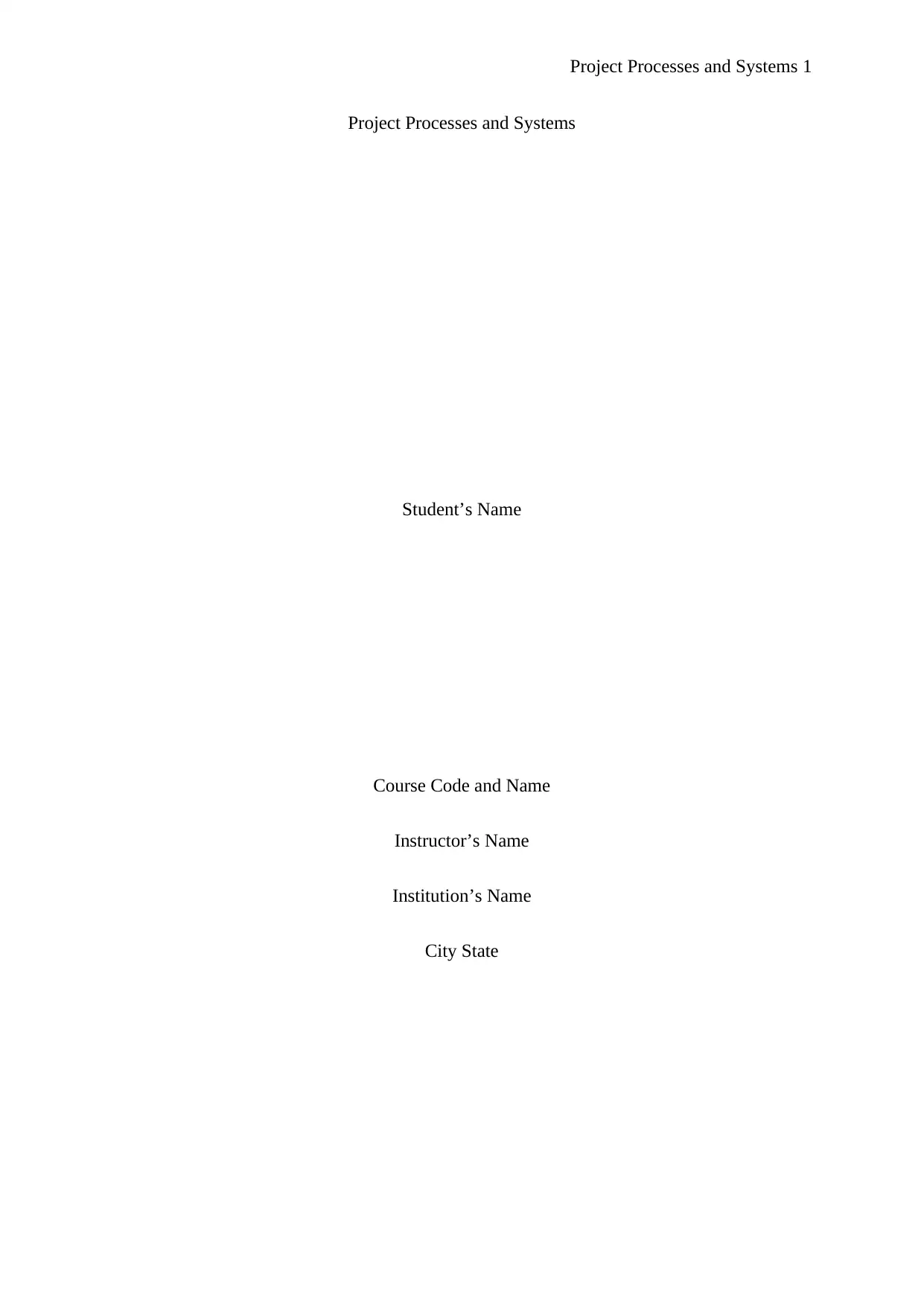
Project Processes and Systems 1
Project Processes and Systems
Student’s Name
Course Code and Name
Instructor’s Name
Institution’s Name
City State
Project Processes and Systems
Student’s Name
Course Code and Name
Instructor’s Name
Institution’s Name
City State
Paraphrase This Document
Need a fresh take? Get an instant paraphrase of this document with our AI Paraphraser
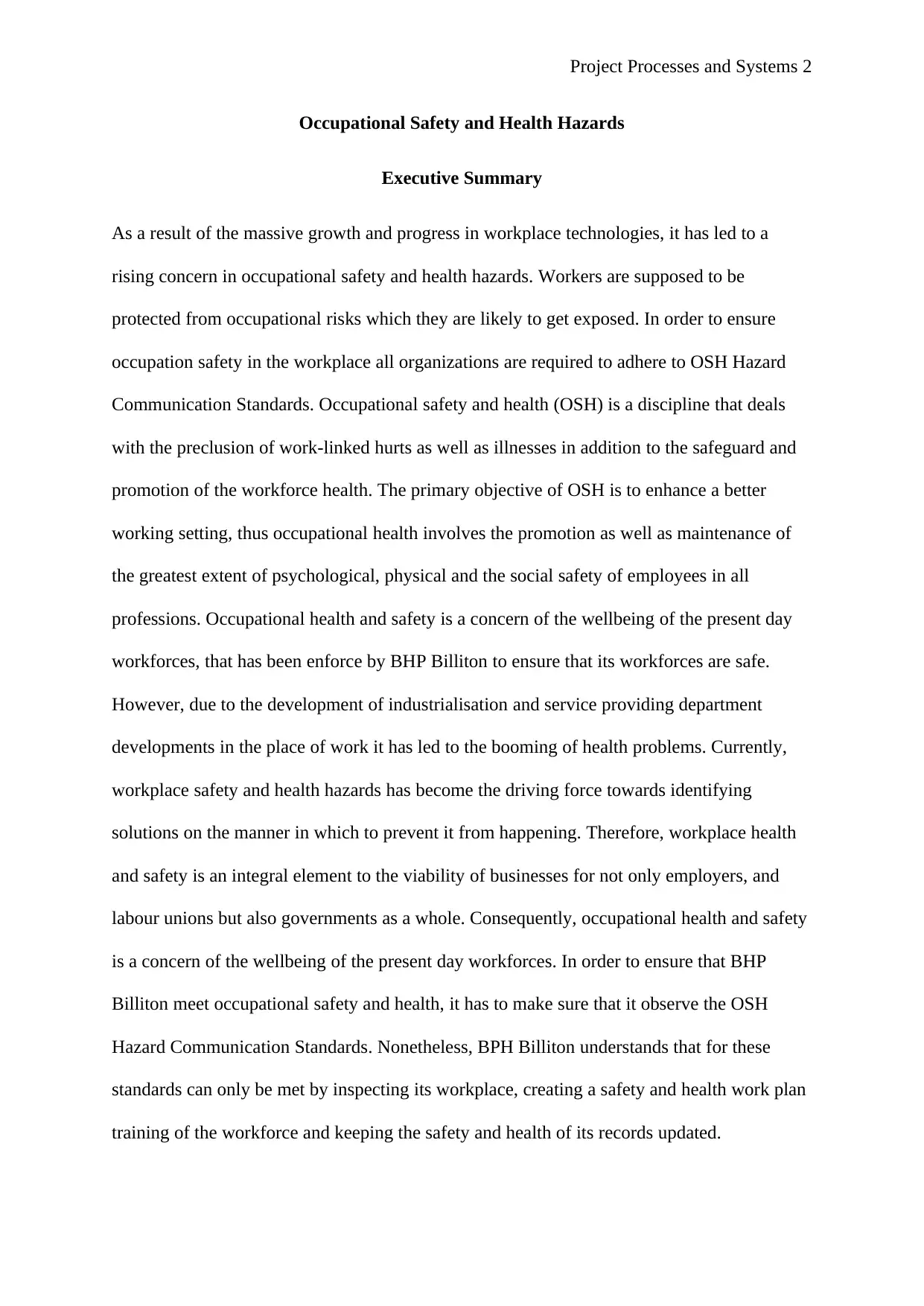
Project Processes and Systems 2
Occupational Safety and Health Hazards
Executive Summary
As a result of the massive growth and progress in workplace technologies, it has led to a
rising concern in occupational safety and health hazards. Workers are supposed to be
protected from occupational risks which they are likely to get exposed. In order to ensure
occupation safety in the workplace all organizations are required to adhere to OSH Hazard
Communication Standards. Occupational safety and health (OSH) is a discipline that deals
with the preclusion of work-linked hurts as well as illnesses in addition to the safeguard and
promotion of the workforce health. The primary objective of OSH is to enhance a better
working setting, thus occupational health involves the promotion as well as maintenance of
the greatest extent of psychological, physical and the social safety of employees in all
professions. Occupational health and safety is a concern of the wellbeing of the present day
workforces, that has been enforce by BHP Billiton to ensure that its workforces are safe.
However, due to the development of industrialisation and service providing department
developments in the place of work it has led to the booming of health problems. Currently,
workplace safety and health hazards has become the driving force towards identifying
solutions on the manner in which to prevent it from happening. Therefore, workplace health
and safety is an integral element to the viability of businesses for not only employers, and
labour unions but also governments as a whole. Consequently, occupational health and safety
is a concern of the wellbeing of the present day workforces. In order to ensure that BHP
Billiton meet occupational safety and health, it has to make sure that it observe the OSH
Hazard Communication Standards. Nonetheless, BPH Billiton understands that for these
standards can only be met by inspecting its workplace, creating a safety and health work plan
training of the workforce and keeping the safety and health of its records updated.
Occupational Safety and Health Hazards
Executive Summary
As a result of the massive growth and progress in workplace technologies, it has led to a
rising concern in occupational safety and health hazards. Workers are supposed to be
protected from occupational risks which they are likely to get exposed. In order to ensure
occupation safety in the workplace all organizations are required to adhere to OSH Hazard
Communication Standards. Occupational safety and health (OSH) is a discipline that deals
with the preclusion of work-linked hurts as well as illnesses in addition to the safeguard and
promotion of the workforce health. The primary objective of OSH is to enhance a better
working setting, thus occupational health involves the promotion as well as maintenance of
the greatest extent of psychological, physical and the social safety of employees in all
professions. Occupational health and safety is a concern of the wellbeing of the present day
workforces, that has been enforce by BHP Billiton to ensure that its workforces are safe.
However, due to the development of industrialisation and service providing department
developments in the place of work it has led to the booming of health problems. Currently,
workplace safety and health hazards has become the driving force towards identifying
solutions on the manner in which to prevent it from happening. Therefore, workplace health
and safety is an integral element to the viability of businesses for not only employers, and
labour unions but also governments as a whole. Consequently, occupational health and safety
is a concern of the wellbeing of the present day workforces. In order to ensure that BHP
Billiton meet occupational safety and health, it has to make sure that it observe the OSH
Hazard Communication Standards. Nonetheless, BPH Billiton understands that for these
standards can only be met by inspecting its workplace, creating a safety and health work plan
training of the workforce and keeping the safety and health of its records updated.
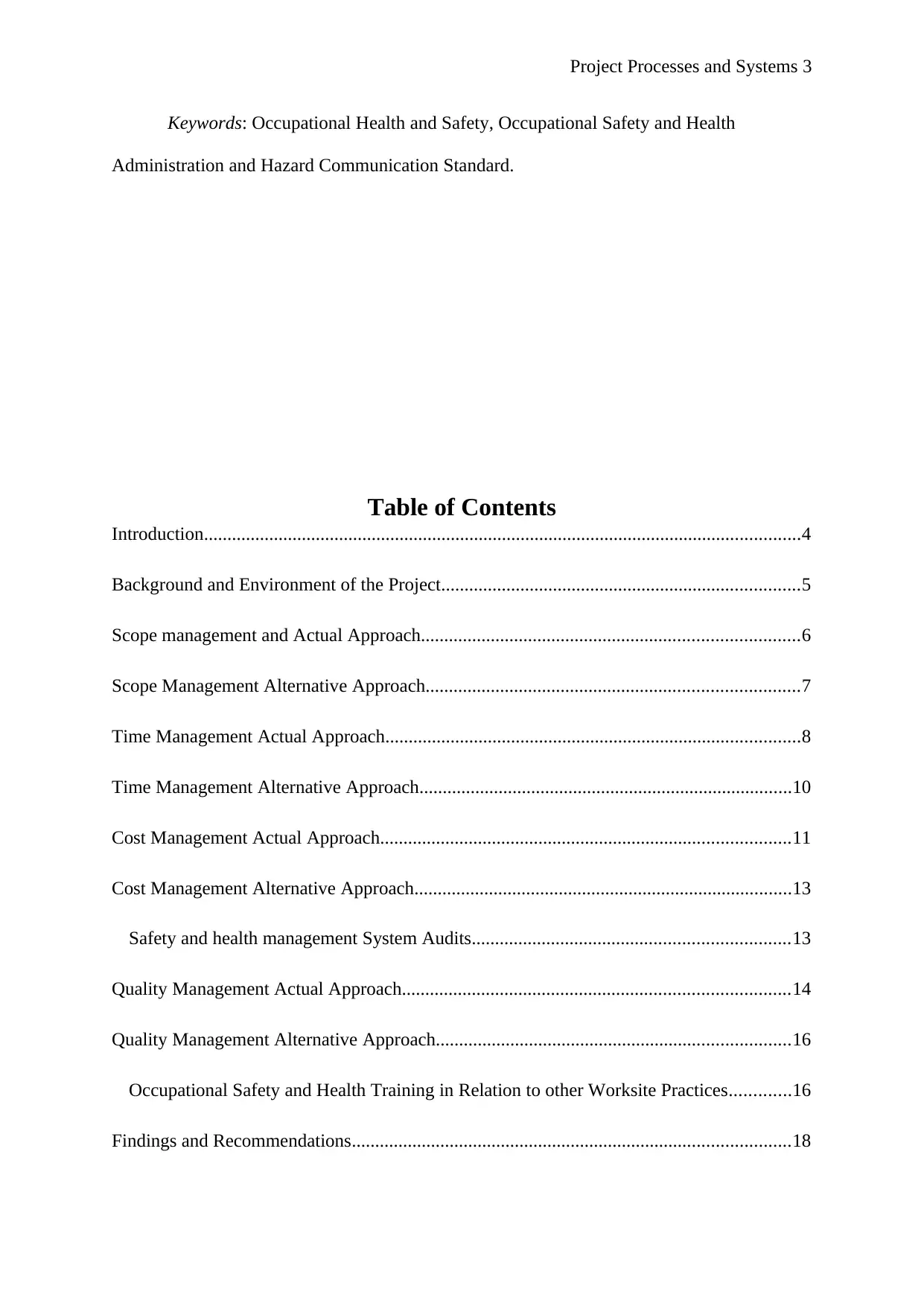
Project Processes and Systems 3
Keywords: Occupational Health and Safety, Occupational Safety and Health
Administration and Hazard Communication Standard.
Table of Contents
Introduction................................................................................................................................4
Background and Environment of the Project.............................................................................5
Scope management and Actual Approach.................................................................................6
Scope Management Alternative Approach................................................................................7
Time Management Actual Approach.........................................................................................8
Time Management Alternative Approach................................................................................10
Cost Management Actual Approach........................................................................................11
Cost Management Alternative Approach.................................................................................13
Safety and health management System Audits....................................................................13
Quality Management Actual Approach...................................................................................14
Quality Management Alternative Approach............................................................................16
Occupational Safety and Health Training in Relation to other Worksite Practices.............16
Findings and Recommendations..............................................................................................18
Keywords: Occupational Health and Safety, Occupational Safety and Health
Administration and Hazard Communication Standard.
Table of Contents
Introduction................................................................................................................................4
Background and Environment of the Project.............................................................................5
Scope management and Actual Approach.................................................................................6
Scope Management Alternative Approach................................................................................7
Time Management Actual Approach.........................................................................................8
Time Management Alternative Approach................................................................................10
Cost Management Actual Approach........................................................................................11
Cost Management Alternative Approach.................................................................................13
Safety and health management System Audits....................................................................13
Quality Management Actual Approach...................................................................................14
Quality Management Alternative Approach............................................................................16
Occupational Safety and Health Training in Relation to other Worksite Practices.............16
Findings and Recommendations..............................................................................................18
⊘ This is a preview!⊘
Do you want full access?
Subscribe today to unlock all pages.

Trusted by 1+ million students worldwide
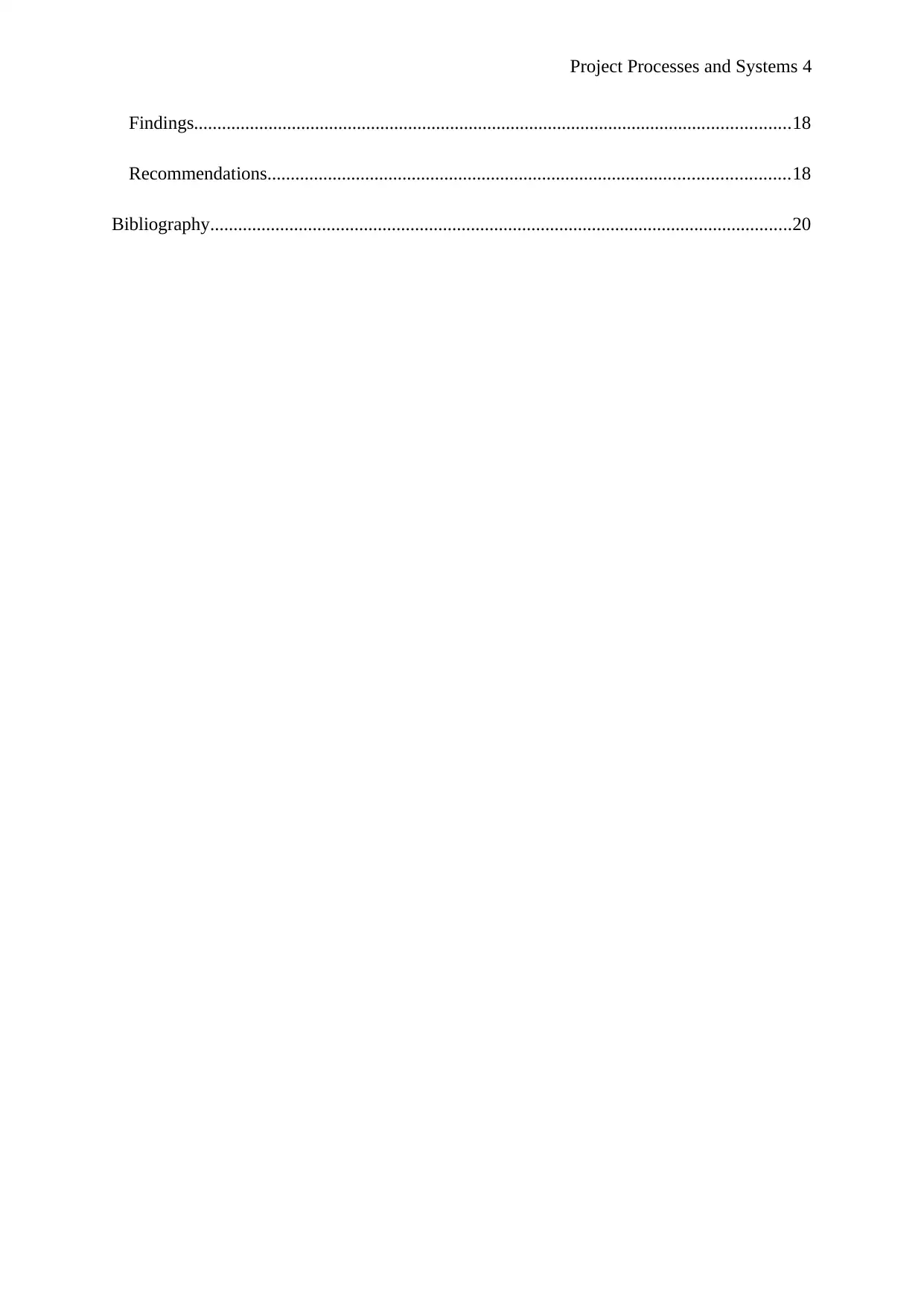
Project Processes and Systems 4
Findings................................................................................................................................18
Recommendations................................................................................................................18
Bibliography.............................................................................................................................20
Findings................................................................................................................................18
Recommendations................................................................................................................18
Bibliography.............................................................................................................................20
Paraphrase This Document
Need a fresh take? Get an instant paraphrase of this document with our AI Paraphraser
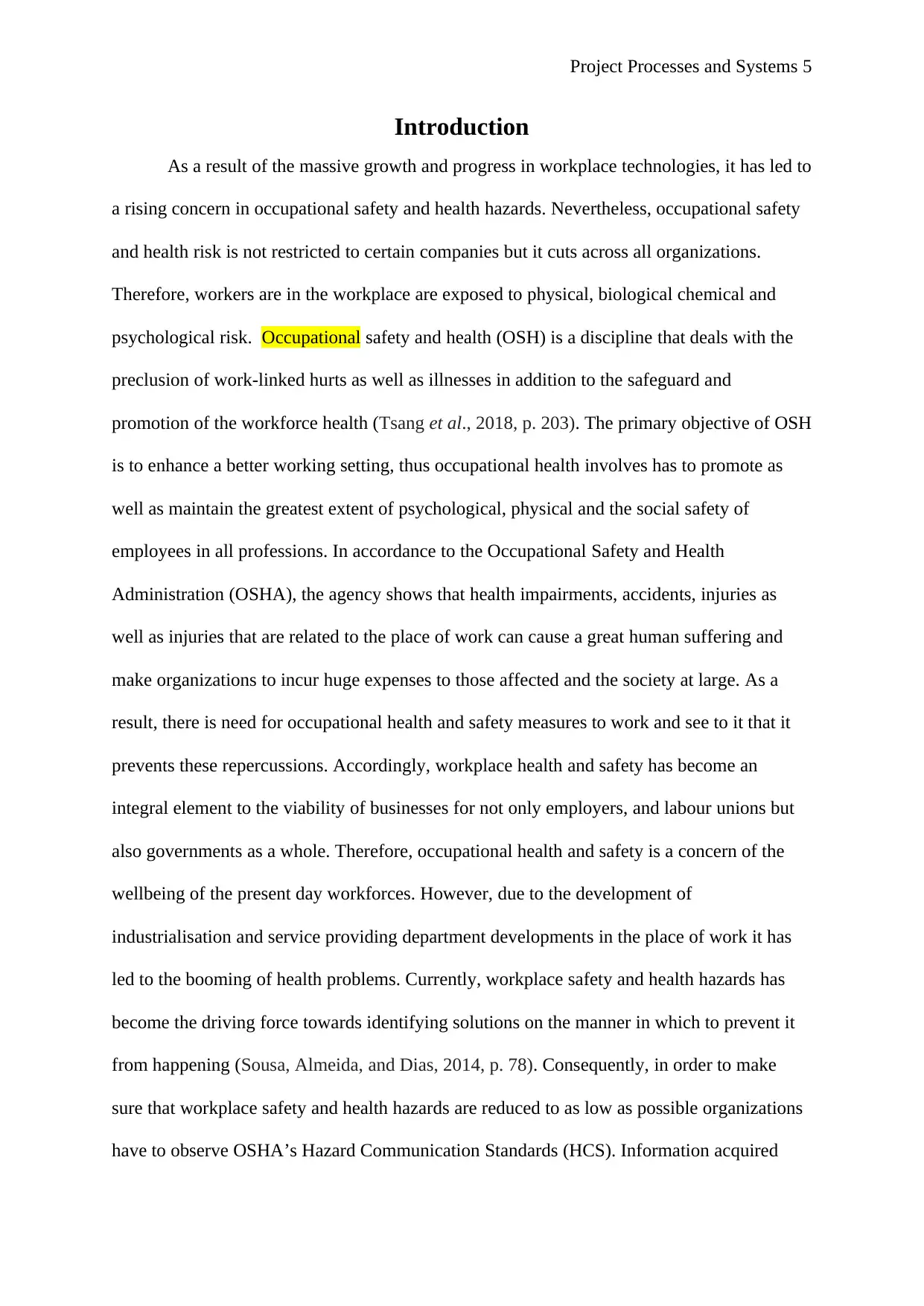
Project Processes and Systems 5
Introduction
As a result of the massive growth and progress in workplace technologies, it has led to
a rising concern in occupational safety and health hazards. Nevertheless, occupational safety
and health risk is not restricted to certain companies but it cuts across all organizations.
Therefore, workers are in the workplace are exposed to physical, biological chemical and
psychological risk. Occupational safety and health (OSH) is a discipline that deals with the
preclusion of work-linked hurts as well as illnesses in addition to the safeguard and
promotion of the workforce health (Tsang et al., 2018, p. 203). The primary objective of OSH
is to enhance a better working setting, thus occupational health involves has to promote as
well as maintain the greatest extent of psychological, physical and the social safety of
employees in all professions. In accordance to the Occupational Safety and Health
Administration (OSHA), the agency shows that health impairments, accidents, injuries as
well as injuries that are related to the place of work can cause a great human suffering and
make organizations to incur huge expenses to those affected and the society at large. As a
result, there is need for occupational health and safety measures to work and see to it that it
prevents these repercussions. Accordingly, workplace health and safety has become an
integral element to the viability of businesses for not only employers, and labour unions but
also governments as a whole. Therefore, occupational health and safety is a concern of the
wellbeing of the present day workforces. However, due to the development of
industrialisation and service providing department developments in the place of work it has
led to the booming of health problems. Currently, workplace safety and health hazards has
become the driving force towards identifying solutions on the manner in which to prevent it
from happening (Sousa, Almeida, and Dias, 2014, p. 78). Consequently, in order to make
sure that workplace safety and health hazards are reduced to as low as possible organizations
have to observe OSHA’s Hazard Communication Standards (HCS). Information acquired
Introduction
As a result of the massive growth and progress in workplace technologies, it has led to
a rising concern in occupational safety and health hazards. Nevertheless, occupational safety
and health risk is not restricted to certain companies but it cuts across all organizations.
Therefore, workers are in the workplace are exposed to physical, biological chemical and
psychological risk. Occupational safety and health (OSH) is a discipline that deals with the
preclusion of work-linked hurts as well as illnesses in addition to the safeguard and
promotion of the workforce health (Tsang et al., 2018, p. 203). The primary objective of OSH
is to enhance a better working setting, thus occupational health involves has to promote as
well as maintain the greatest extent of psychological, physical and the social safety of
employees in all professions. In accordance to the Occupational Safety and Health
Administration (OSHA), the agency shows that health impairments, accidents, injuries as
well as injuries that are related to the place of work can cause a great human suffering and
make organizations to incur huge expenses to those affected and the society at large. As a
result, there is need for occupational health and safety measures to work and see to it that it
prevents these repercussions. Accordingly, workplace health and safety has become an
integral element to the viability of businesses for not only employers, and labour unions but
also governments as a whole. Therefore, occupational health and safety is a concern of the
wellbeing of the present day workforces. However, due to the development of
industrialisation and service providing department developments in the place of work it has
led to the booming of health problems. Currently, workplace safety and health hazards has
become the driving force towards identifying solutions on the manner in which to prevent it
from happening (Sousa, Almeida, and Dias, 2014, p. 78). Consequently, in order to make
sure that workplace safety and health hazards are reduced to as low as possible organizations
have to observe OSHA’s Hazard Communication Standards (HCS). Information acquired
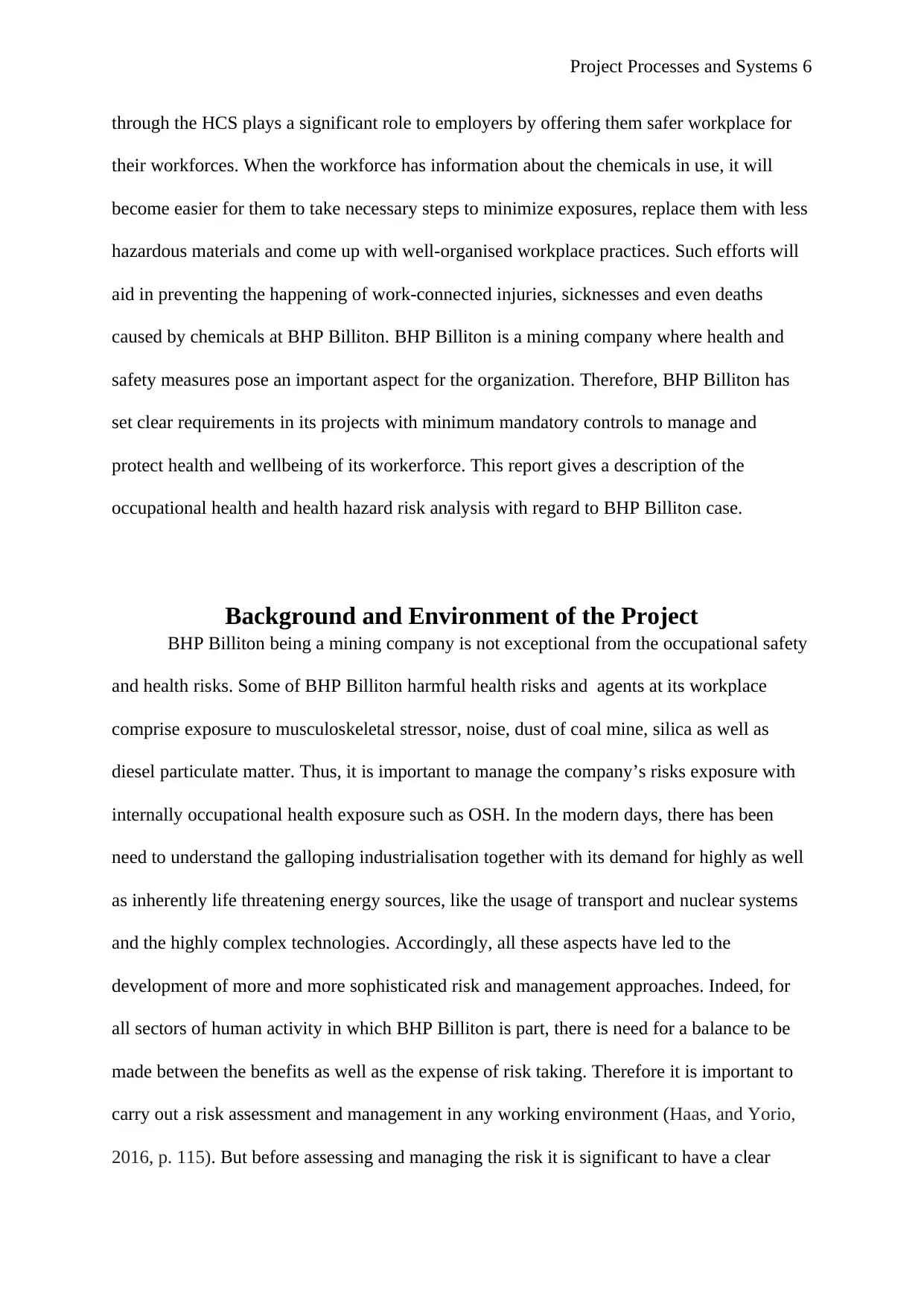
Project Processes and Systems 6
through the HCS plays a significant role to employers by offering them safer workplace for
their workforces. When the workforce has information about the chemicals in use, it will
become easier for them to take necessary steps to minimize exposures, replace them with less
hazardous materials and come up with well-organised workplace practices. Such efforts will
aid in preventing the happening of work-connected injuries, sicknesses and even deaths
caused by chemicals at BHP Billiton. BHP Billiton is a mining company where health and
safety measures pose an important aspect for the organization. Therefore, BHP Billiton has
set clear requirements in its projects with minimum mandatory controls to manage and
protect health and wellbeing of its workerforce. This report gives a description of the
occupational health and health hazard risk analysis with regard to BHP Billiton case.
Background and Environment of the Project
BHP Billiton being a mining company is not exceptional from the occupational safety
and health risks. Some of BHP Billiton harmful health risks and agents at its workplace
comprise exposure to musculoskeletal stressor, noise, dust of coal mine, silica as well as
diesel particulate matter. Thus, it is important to manage the company’s risks exposure with
internally occupational health exposure such as OSH. In the modern days, there has been
need to understand the galloping industrialisation together with its demand for highly as well
as inherently life threatening energy sources, like the usage of transport and nuclear systems
and the highly complex technologies. Accordingly, all these aspects have led to the
development of more and more sophisticated risk and management approaches. Indeed, for
all sectors of human activity in which BHP Billiton is part, there is need for a balance to be
made between the benefits as well as the expense of risk taking. Therefore it is important to
carry out a risk assessment and management in any working environment (Haas, and Yorio,
2016, p. 115). But before assessing and managing the risk it is significant to have a clear
through the HCS plays a significant role to employers by offering them safer workplace for
their workforces. When the workforce has information about the chemicals in use, it will
become easier for them to take necessary steps to minimize exposures, replace them with less
hazardous materials and come up with well-organised workplace practices. Such efforts will
aid in preventing the happening of work-connected injuries, sicknesses and even deaths
caused by chemicals at BHP Billiton. BHP Billiton is a mining company where health and
safety measures pose an important aspect for the organization. Therefore, BHP Billiton has
set clear requirements in its projects with minimum mandatory controls to manage and
protect health and wellbeing of its workerforce. This report gives a description of the
occupational health and health hazard risk analysis with regard to BHP Billiton case.
Background and Environment of the Project
BHP Billiton being a mining company is not exceptional from the occupational safety
and health risks. Some of BHP Billiton harmful health risks and agents at its workplace
comprise exposure to musculoskeletal stressor, noise, dust of coal mine, silica as well as
diesel particulate matter. Thus, it is important to manage the company’s risks exposure with
internally occupational health exposure such as OSH. In the modern days, there has been
need to understand the galloping industrialisation together with its demand for highly as well
as inherently life threatening energy sources, like the usage of transport and nuclear systems
and the highly complex technologies. Accordingly, all these aspects have led to the
development of more and more sophisticated risk and management approaches. Indeed, for
all sectors of human activity in which BHP Billiton is part, there is need for a balance to be
made between the benefits as well as the expense of risk taking. Therefore it is important to
carry out a risk assessment and management in any working environment (Haas, and Yorio,
2016, p. 115). But before assessing and managing the risk it is significant to have a clear
⊘ This is a preview!⊘
Do you want full access?
Subscribe today to unlock all pages.

Trusted by 1+ million students worldwide
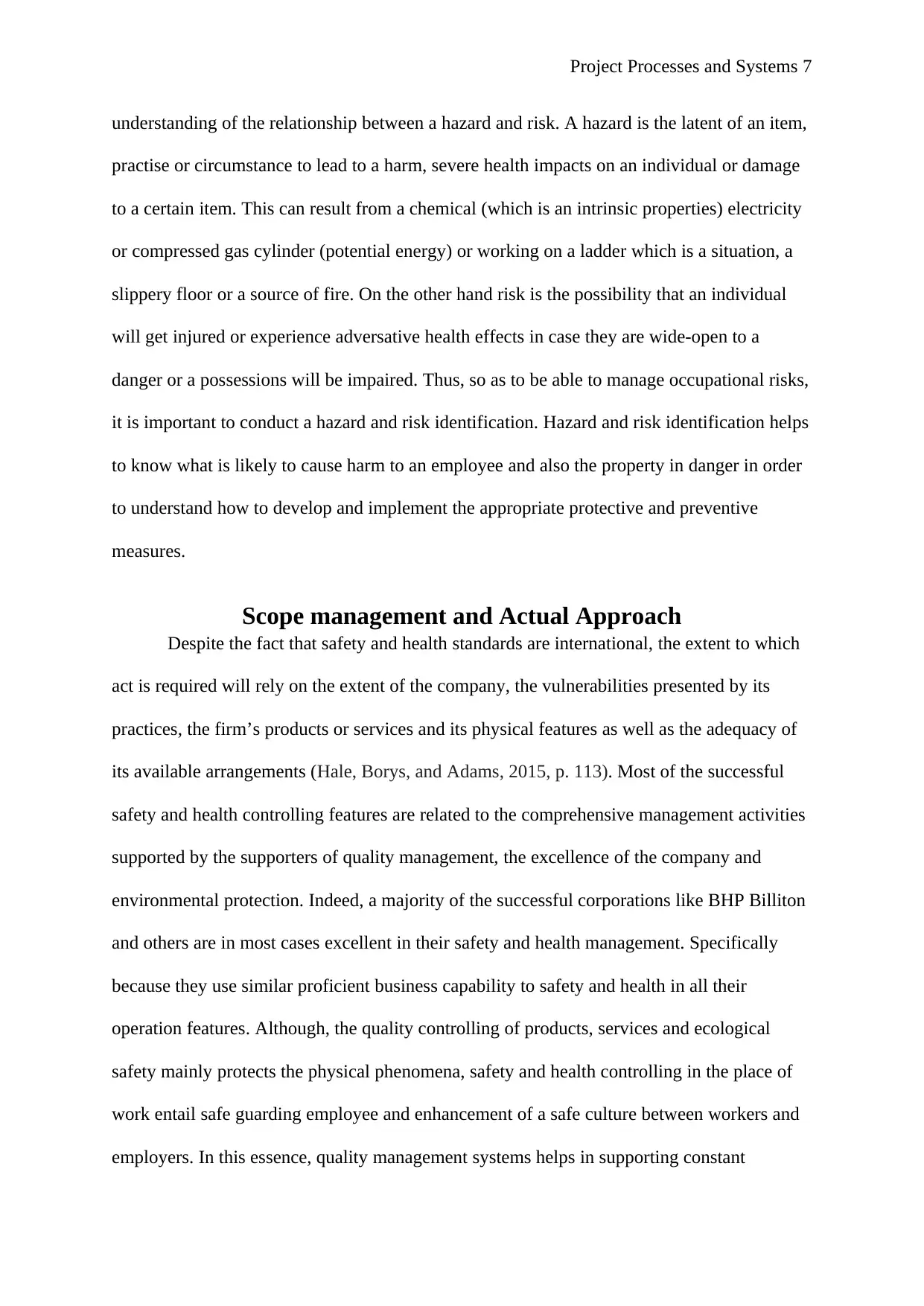
Project Processes and Systems 7
understanding of the relationship between a hazard and risk. A hazard is the latent of an item,
practise or circumstance to lead to a harm, severe health impacts on an individual or damage
to a certain item. This can result from a chemical (which is an intrinsic properties) electricity
or compressed gas cylinder (potential energy) or working on a ladder which is a situation, a
slippery floor or a source of fire. On the other hand risk is the possibility that an individual
will get injured or experience adversative health effects in case they are wide-open to a
danger or a possessions will be impaired. Thus, so as to be able to manage occupational risks,
it is important to conduct a hazard and risk identification. Hazard and risk identification helps
to know what is likely to cause harm to an employee and also the property in danger in order
to understand how to develop and implement the appropriate protective and preventive
measures.
Scope management and Actual Approach
Despite the fact that safety and health standards are international, the extent to which
act is required will rely on the extent of the company, the vulnerabilities presented by its
practices, the firm’s products or services and its physical features as well as the adequacy of
its available arrangements (Hale, Borys, and Adams, 2015, p. 113). Most of the successful
safety and health controlling features are related to the comprehensive management activities
supported by the supporters of quality management, the excellence of the company and
environmental protection. Indeed, a majority of the successful corporations like BHP Billiton
and others are in most cases excellent in their safety and health management. Specifically
because they use similar proficient business capability to safety and health in all their
operation features. Although, the quality controlling of products, services and ecological
safety mainly protects the physical phenomena, safety and health controlling in the place of
work entail safe guarding employee and enhancement of a safe culture between workers and
employers. In this essence, quality management systems helps in supporting constant
understanding of the relationship between a hazard and risk. A hazard is the latent of an item,
practise or circumstance to lead to a harm, severe health impacts on an individual or damage
to a certain item. This can result from a chemical (which is an intrinsic properties) electricity
or compressed gas cylinder (potential energy) or working on a ladder which is a situation, a
slippery floor or a source of fire. On the other hand risk is the possibility that an individual
will get injured or experience adversative health effects in case they are wide-open to a
danger or a possessions will be impaired. Thus, so as to be able to manage occupational risks,
it is important to conduct a hazard and risk identification. Hazard and risk identification helps
to know what is likely to cause harm to an employee and also the property in danger in order
to understand how to develop and implement the appropriate protective and preventive
measures.
Scope management and Actual Approach
Despite the fact that safety and health standards are international, the extent to which
act is required will rely on the extent of the company, the vulnerabilities presented by its
practices, the firm’s products or services and its physical features as well as the adequacy of
its available arrangements (Hale, Borys, and Adams, 2015, p. 113). Most of the successful
safety and health controlling features are related to the comprehensive management activities
supported by the supporters of quality management, the excellence of the company and
environmental protection. Indeed, a majority of the successful corporations like BHP Billiton
and others are in most cases excellent in their safety and health management. Specifically
because they use similar proficient business capability to safety and health in all their
operation features. Although, the quality controlling of products, services and ecological
safety mainly protects the physical phenomena, safety and health controlling in the place of
work entail safe guarding employee and enhancement of a safe culture between workers and
employers. In this essence, quality management systems helps in supporting constant
Paraphrase This Document
Need a fresh take? Get an instant paraphrase of this document with our AI Paraphraser
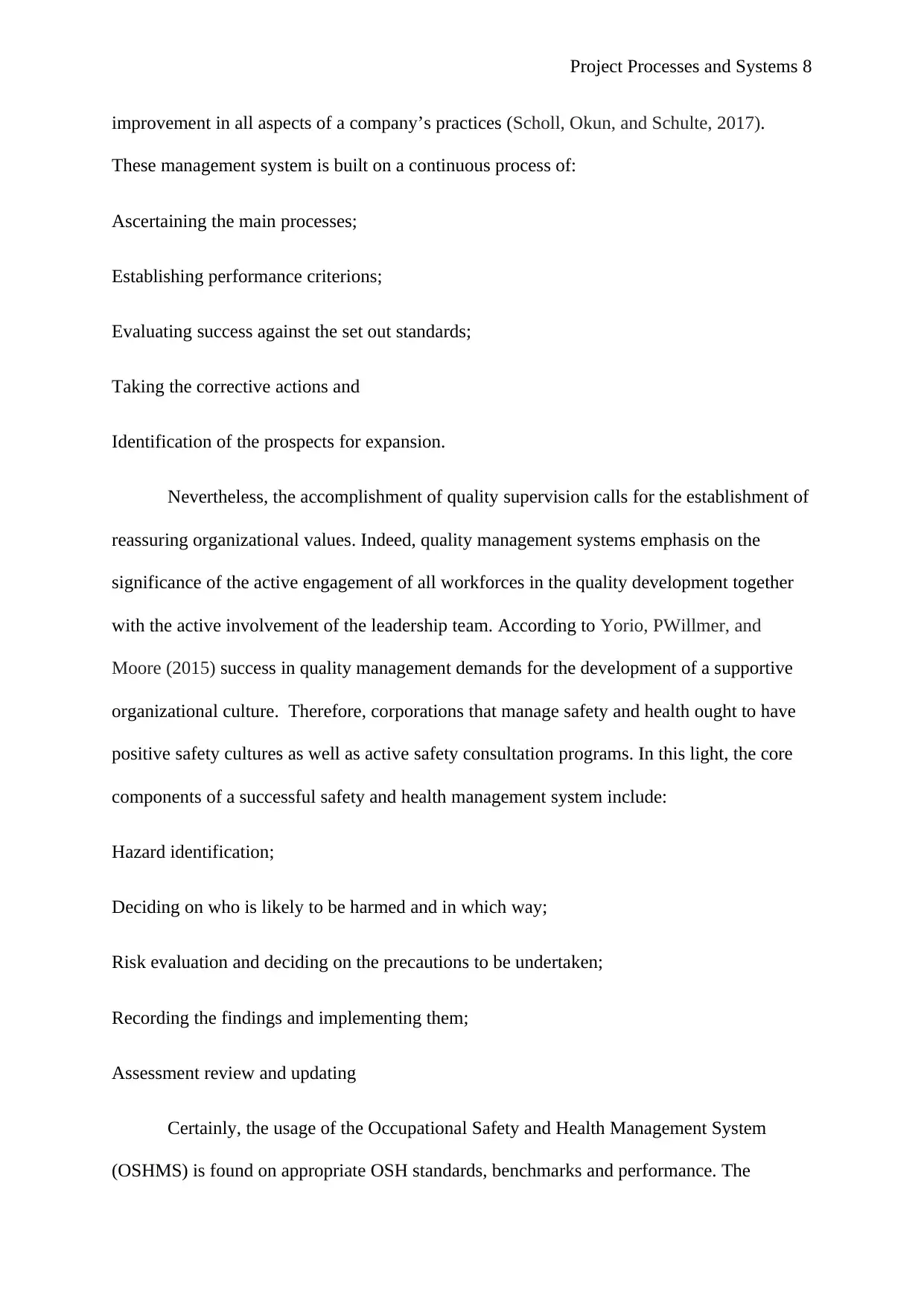
Project Processes and Systems 8
improvement in all aspects of a company’s practices (Scholl, Okun, and Schulte, 2017).
These management system is built on a continuous process of:
Ascertaining the main processes;
Establishing performance criterions;
Evaluating success against the set out standards;
Taking the corrective actions and
Identification of the prospects for expansion.
Nevertheless, the accomplishment of quality supervision calls for the establishment of
reassuring organizational values. Indeed, quality management systems emphasis on the
significance of the active engagement of all workforces in the quality development together
with the active involvement of the leadership team. According to Yorio, PWillmer, and
Moore (2015) success in quality management demands for the development of a supportive
organizational culture. Therefore, corporations that manage safety and health ought to have
positive safety cultures as well as active safety consultation programs. In this light, the core
components of a successful safety and health management system include:
Hazard identification;
Deciding on who is likely to be harmed and in which way;
Risk evaluation and deciding on the precautions to be undertaken;
Recording the findings and implementing them;
Assessment review and updating
Certainly, the usage of the Occupational Safety and Health Management System
(OSHMS) is found on appropriate OSH standards, benchmarks and performance. The
improvement in all aspects of a company’s practices (Scholl, Okun, and Schulte, 2017).
These management system is built on a continuous process of:
Ascertaining the main processes;
Establishing performance criterions;
Evaluating success against the set out standards;
Taking the corrective actions and
Identification of the prospects for expansion.
Nevertheless, the accomplishment of quality supervision calls for the establishment of
reassuring organizational values. Indeed, quality management systems emphasis on the
significance of the active engagement of all workforces in the quality development together
with the active involvement of the leadership team. According to Yorio, PWillmer, and
Moore (2015) success in quality management demands for the development of a supportive
organizational culture. Therefore, corporations that manage safety and health ought to have
positive safety cultures as well as active safety consultation programs. In this light, the core
components of a successful safety and health management system include:
Hazard identification;
Deciding on who is likely to be harmed and in which way;
Risk evaluation and deciding on the precautions to be undertaken;
Recording the findings and implementing them;
Assessment review and updating
Certainly, the usage of the Occupational Safety and Health Management System
(OSHMS) is found on appropriate OSH standards, benchmarks and performance. The
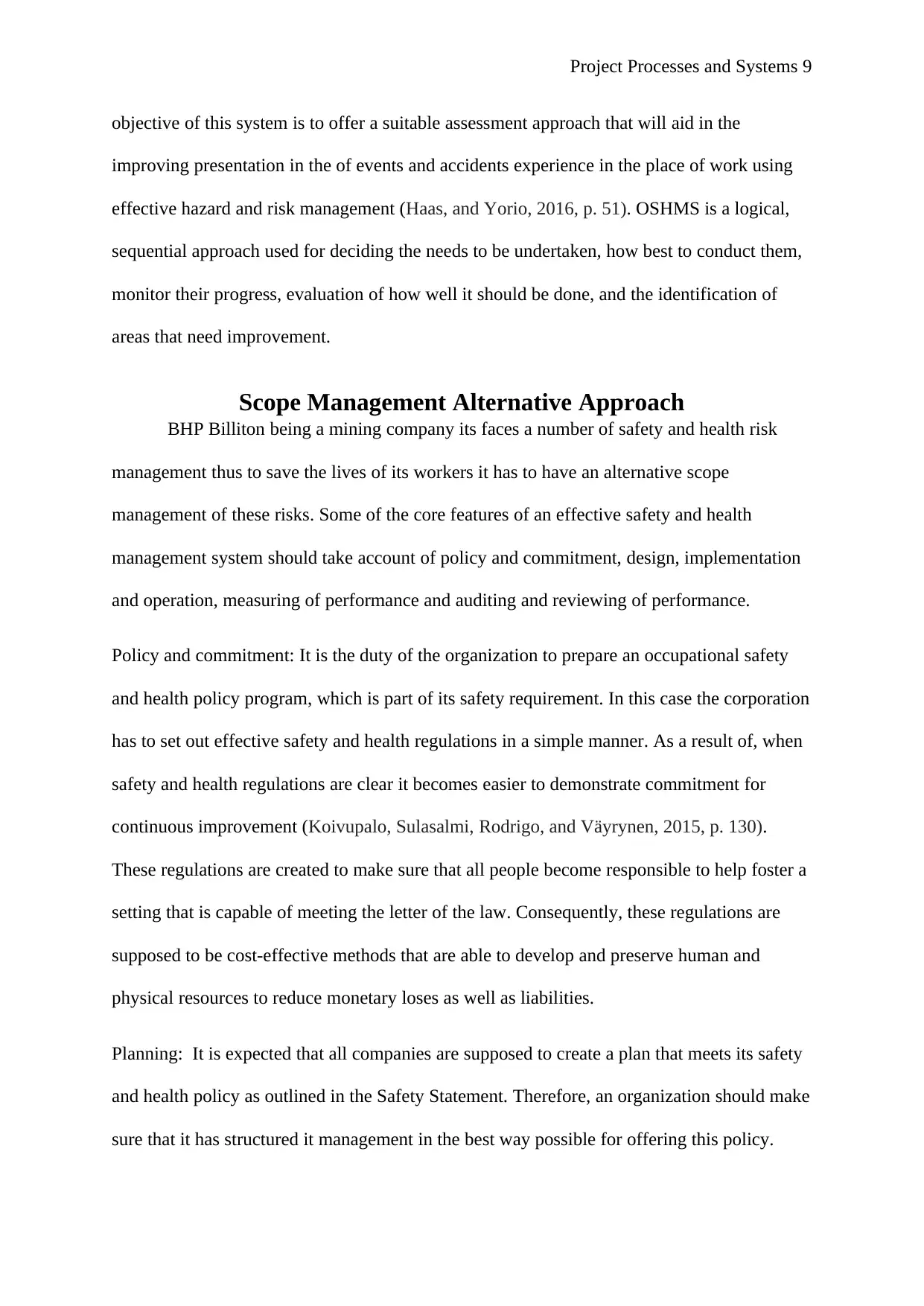
Project Processes and Systems 9
objective of this system is to offer a suitable assessment approach that will aid in the
improving presentation in the of events and accidents experience in the place of work using
effective hazard and risk management (Haas, and Yorio, 2016, p. 51). OSHMS is a logical,
sequential approach used for deciding the needs to be undertaken, how best to conduct them,
monitor their progress, evaluation of how well it should be done, and the identification of
areas that need improvement.
Scope Management Alternative Approach
BHP Billiton being a mining company its faces a number of safety and health risk
management thus to save the lives of its workers it has to have an alternative scope
management of these risks. Some of the core features of an effective safety and health
management system should take account of policy and commitment, design, implementation
and operation, measuring of performance and auditing and reviewing of performance.
Policy and commitment: It is the duty of the organization to prepare an occupational safety
and health policy program, which is part of its safety requirement. In this case the corporation
has to set out effective safety and health regulations in a simple manner. As a result of, when
safety and health regulations are clear it becomes easier to demonstrate commitment for
continuous improvement (Koivupalo, Sulasalmi, Rodrigo, and Väyrynen, 2015, p. 130).
These regulations are created to make sure that all people become responsible to help foster a
setting that is capable of meeting the letter of the law. Consequently, these regulations are
supposed to be cost-effective methods that are able to develop and preserve human and
physical resources to reduce monetary loses as well as liabilities.
Planning: It is expected that all companies are supposed to create a plan that meets its safety
and health policy as outlined in the Safety Statement. Therefore, an organization should make
sure that it has structured it management in the best way possible for offering this policy.
objective of this system is to offer a suitable assessment approach that will aid in the
improving presentation in the of events and accidents experience in the place of work using
effective hazard and risk management (Haas, and Yorio, 2016, p. 51). OSHMS is a logical,
sequential approach used for deciding the needs to be undertaken, how best to conduct them,
monitor their progress, evaluation of how well it should be done, and the identification of
areas that need improvement.
Scope Management Alternative Approach
BHP Billiton being a mining company its faces a number of safety and health risk
management thus to save the lives of its workers it has to have an alternative scope
management of these risks. Some of the core features of an effective safety and health
management system should take account of policy and commitment, design, implementation
and operation, measuring of performance and auditing and reviewing of performance.
Policy and commitment: It is the duty of the organization to prepare an occupational safety
and health policy program, which is part of its safety requirement. In this case the corporation
has to set out effective safety and health regulations in a simple manner. As a result of, when
safety and health regulations are clear it becomes easier to demonstrate commitment for
continuous improvement (Koivupalo, Sulasalmi, Rodrigo, and Väyrynen, 2015, p. 130).
These regulations are created to make sure that all people become responsible to help foster a
setting that is capable of meeting the letter of the law. Consequently, these regulations are
supposed to be cost-effective methods that are able to develop and preserve human and
physical resources to reduce monetary loses as well as liabilities.
Planning: It is expected that all companies are supposed to create a plan that meets its safety
and health policy as outlined in the Safety Statement. Therefore, an organization should make
sure that it has structured it management in the best way possible for offering this policy.
⊘ This is a preview!⊘
Do you want full access?
Subscribe today to unlock all pages.

Trusted by 1+ million students worldwide
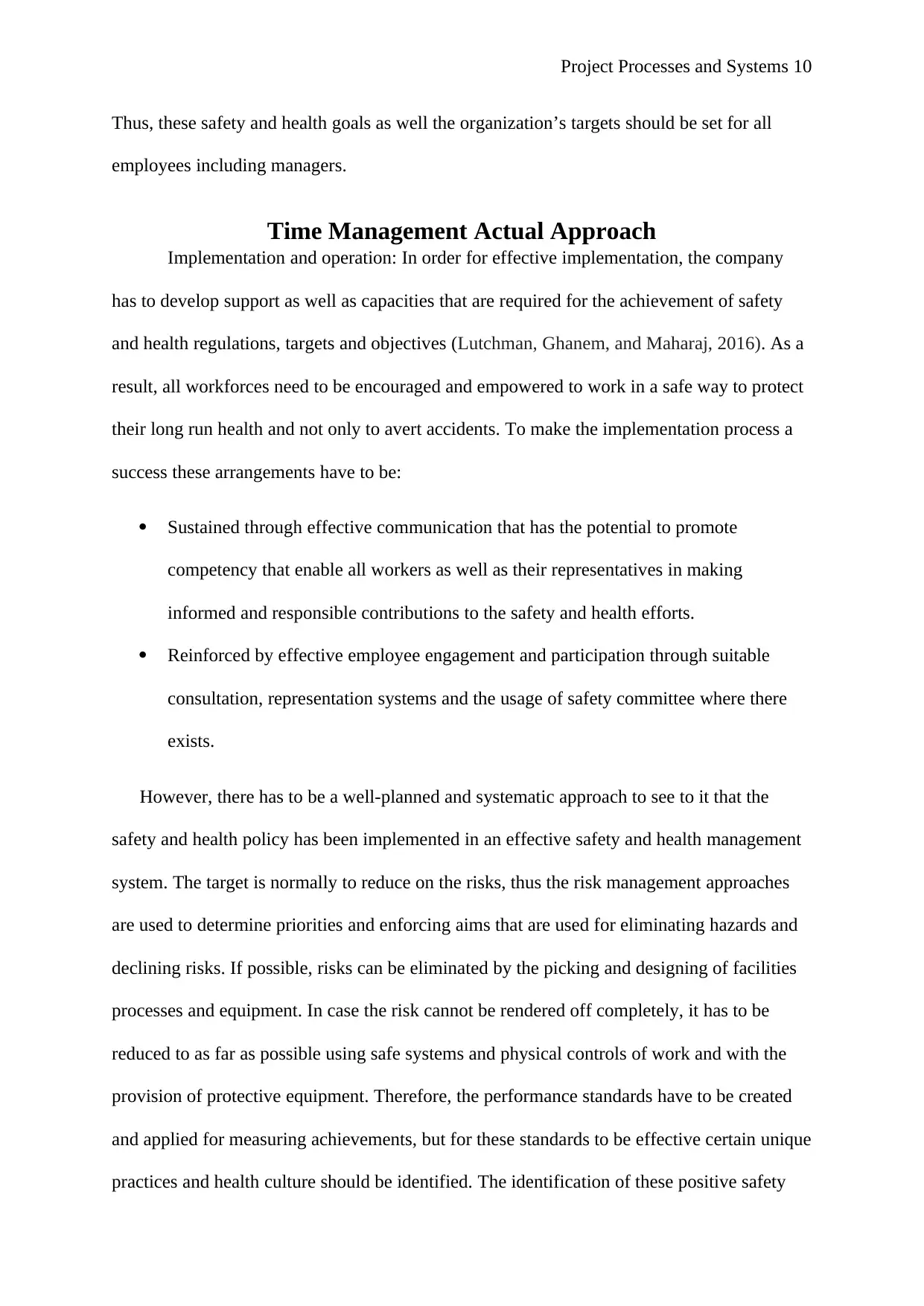
Project Processes and Systems 10
Thus, these safety and health goals as well the organization’s targets should be set for all
employees including managers.
Time Management Actual Approach
Implementation and operation: In order for effective implementation, the company
has to develop support as well as capacities that are required for the achievement of safety
and health regulations, targets and objectives (Lutchman, Ghanem, and Maharaj, 2016). As a
result, all workforces need to be encouraged and empowered to work in a safe way to protect
their long run health and not only to avert accidents. To make the implementation process a
success these arrangements have to be:
Sustained through effective communication that has the potential to promote
competency that enable all workers as well as their representatives in making
informed and responsible contributions to the safety and health efforts.
Reinforced by effective employee engagement and participation through suitable
consultation, representation systems and the usage of safety committee where there
exists.
However, there has to be a well-planned and systematic approach to see to it that the
safety and health policy has been implemented in an effective safety and health management
system. The target is normally to reduce on the risks, thus the risk management approaches
are used to determine priorities and enforcing aims that are used for eliminating hazards and
declining risks. If possible, risks can be eliminated by the picking and designing of facilities
processes and equipment. In case the risk cannot be rendered off completely, it has to be
reduced to as far as possible using safe systems and physical controls of work and with the
provision of protective equipment. Therefore, the performance standards have to be created
and applied for measuring achievements, but for these standards to be effective certain unique
practices and health culture should be identified. The identification of these positive safety
Thus, these safety and health goals as well the organization’s targets should be set for all
employees including managers.
Time Management Actual Approach
Implementation and operation: In order for effective implementation, the company
has to develop support as well as capacities that are required for the achievement of safety
and health regulations, targets and objectives (Lutchman, Ghanem, and Maharaj, 2016). As a
result, all workforces need to be encouraged and empowered to work in a safe way to protect
their long run health and not only to avert accidents. To make the implementation process a
success these arrangements have to be:
Sustained through effective communication that has the potential to promote
competency that enable all workers as well as their representatives in making
informed and responsible contributions to the safety and health efforts.
Reinforced by effective employee engagement and participation through suitable
consultation, representation systems and the usage of safety committee where there
exists.
However, there has to be a well-planned and systematic approach to see to it that the
safety and health policy has been implemented in an effective safety and health management
system. The target is normally to reduce on the risks, thus the risk management approaches
are used to determine priorities and enforcing aims that are used for eliminating hazards and
declining risks. If possible, risks can be eliminated by the picking and designing of facilities
processes and equipment. In case the risk cannot be rendered off completely, it has to be
reduced to as far as possible using safe systems and physical controls of work and with the
provision of protective equipment. Therefore, the performance standards have to be created
and applied for measuring achievements, but for these standards to be effective certain unique
practices and health culture should be identified. The identification of these positive safety
Paraphrase This Document
Need a fresh take? Get an instant paraphrase of this document with our AI Paraphraser
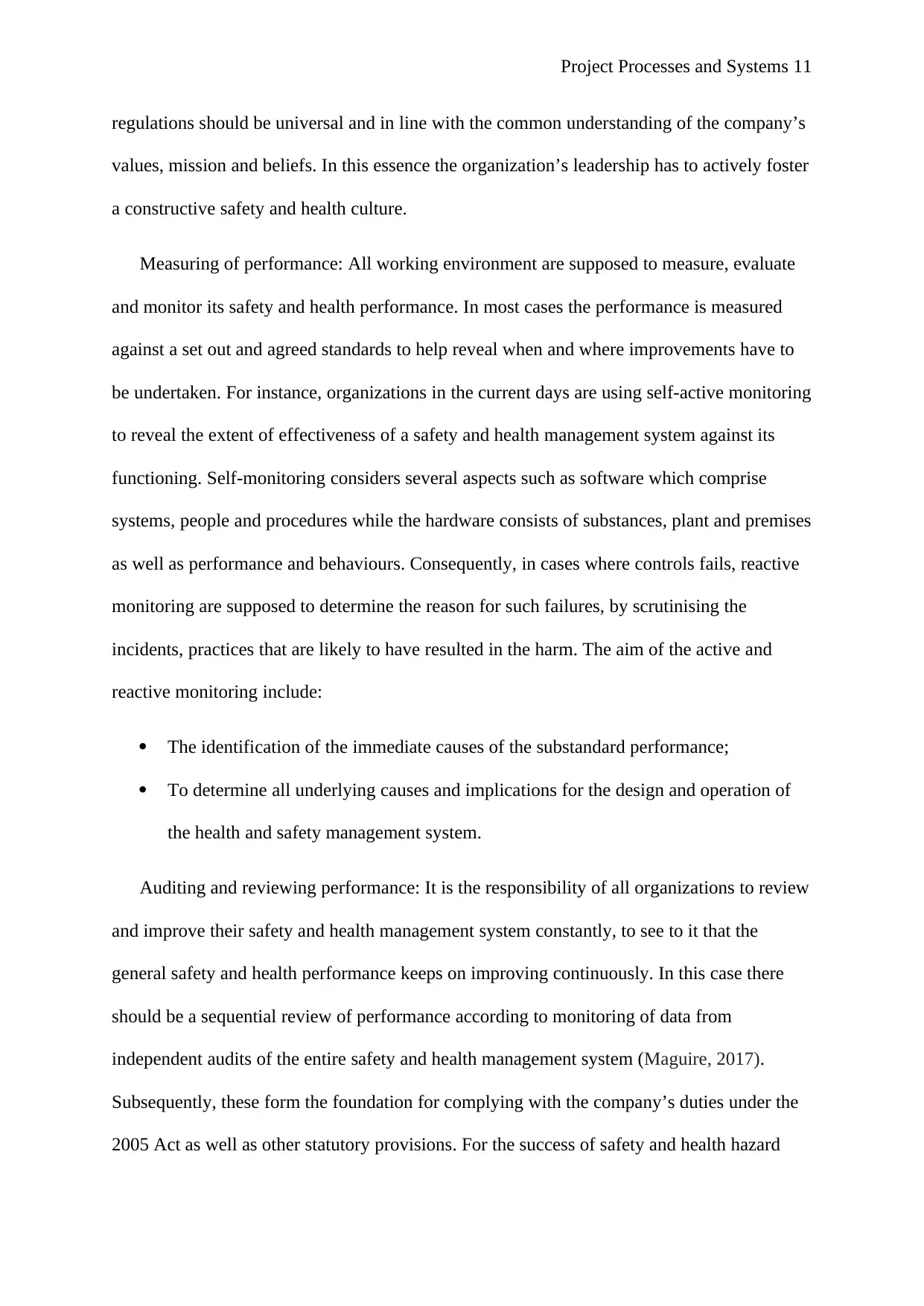
Project Processes and Systems 11
regulations should be universal and in line with the common understanding of the company’s
values, mission and beliefs. In this essence the organization’s leadership has to actively foster
a constructive safety and health culture.
Measuring of performance: All working environment are supposed to measure, evaluate
and monitor its safety and health performance. In most cases the performance is measured
against a set out and agreed standards to help reveal when and where improvements have to
be undertaken. For instance, organizations in the current days are using self-active monitoring
to reveal the extent of effectiveness of a safety and health management system against its
functioning. Self-monitoring considers several aspects such as software which comprise
systems, people and procedures while the hardware consists of substances, plant and premises
as well as performance and behaviours. Consequently, in cases where controls fails, reactive
monitoring are supposed to determine the reason for such failures, by scrutinising the
incidents, practices that are likely to have resulted in the harm. The aim of the active and
reactive monitoring include:
The identification of the immediate causes of the substandard performance;
To determine all underlying causes and implications for the design and operation of
the health and safety management system.
Auditing and reviewing performance: It is the responsibility of all organizations to review
and improve their safety and health management system constantly, to see to it that the
general safety and health performance keeps on improving continuously. In this case there
should be a sequential review of performance according to monitoring of data from
independent audits of the entire safety and health management system (Maguire, 2017).
Subsequently, these form the foundation for complying with the company’s duties under the
2005 Act as well as other statutory provisions. For the success of safety and health hazard
regulations should be universal and in line with the common understanding of the company’s
values, mission and beliefs. In this essence the organization’s leadership has to actively foster
a constructive safety and health culture.
Measuring of performance: All working environment are supposed to measure, evaluate
and monitor its safety and health performance. In most cases the performance is measured
against a set out and agreed standards to help reveal when and where improvements have to
be undertaken. For instance, organizations in the current days are using self-active monitoring
to reveal the extent of effectiveness of a safety and health management system against its
functioning. Self-monitoring considers several aspects such as software which comprise
systems, people and procedures while the hardware consists of substances, plant and premises
as well as performance and behaviours. Consequently, in cases where controls fails, reactive
monitoring are supposed to determine the reason for such failures, by scrutinising the
incidents, practices that are likely to have resulted in the harm. The aim of the active and
reactive monitoring include:
The identification of the immediate causes of the substandard performance;
To determine all underlying causes and implications for the design and operation of
the health and safety management system.
Auditing and reviewing performance: It is the responsibility of all organizations to review
and improve their safety and health management system constantly, to see to it that the
general safety and health performance keeps on improving continuously. In this case there
should be a sequential review of performance according to monitoring of data from
independent audits of the entire safety and health management system (Maguire, 2017).
Subsequently, these form the foundation for complying with the company’s duties under the
2005 Act as well as other statutory provisions. For the success of safety and health hazard
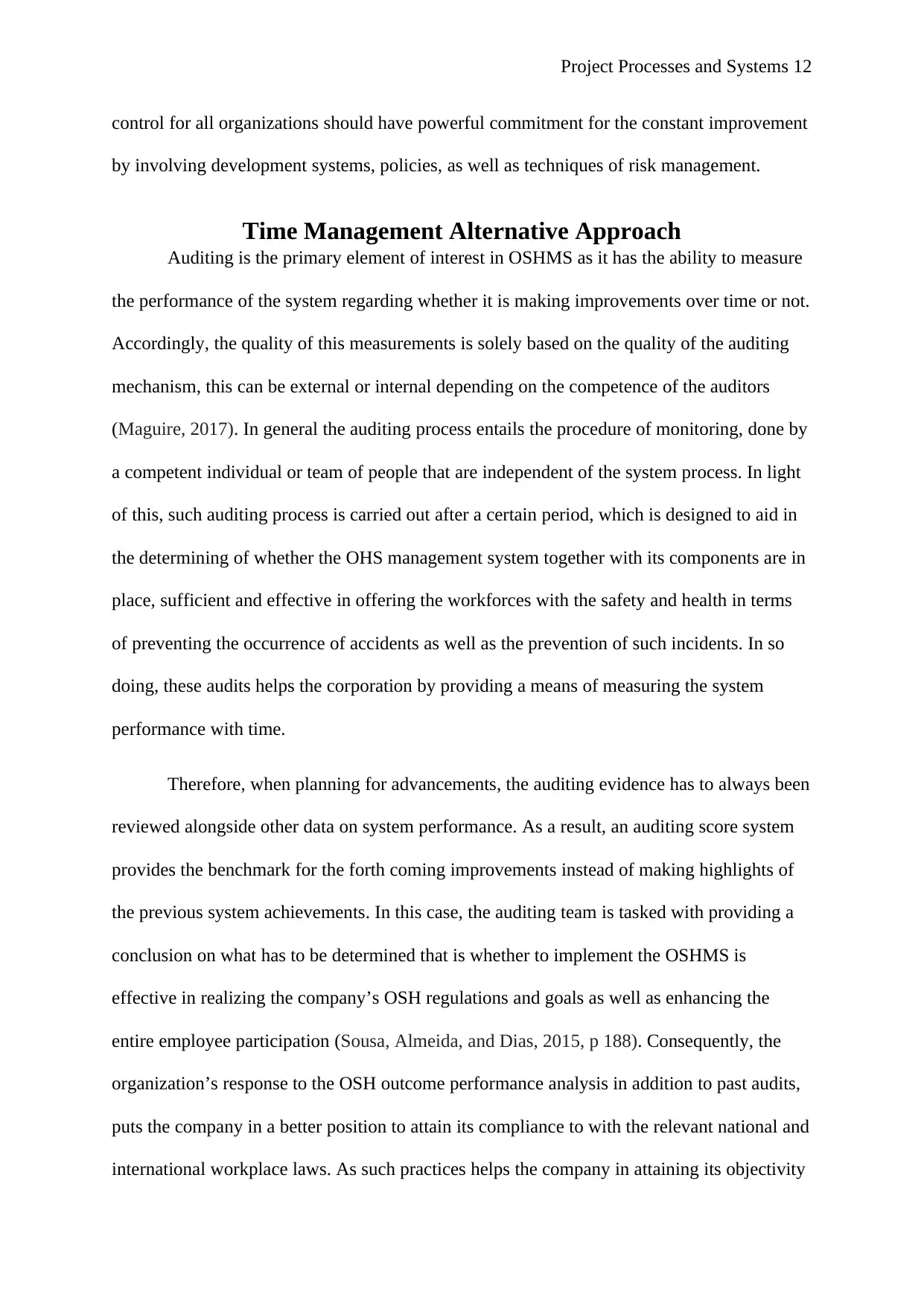
Project Processes and Systems 12
control for all organizations should have powerful commitment for the constant improvement
by involving development systems, policies, as well as techniques of risk management.
Time Management Alternative Approach
Auditing is the primary element of interest in OSHMS as it has the ability to measure
the performance of the system regarding whether it is making improvements over time or not.
Accordingly, the quality of this measurements is solely based on the quality of the auditing
mechanism, this can be external or internal depending on the competence of the auditors
(Maguire, 2017). In general the auditing process entails the procedure of monitoring, done by
a competent individual or team of people that are independent of the system process. In light
of this, such auditing process is carried out after a certain period, which is designed to aid in
the determining of whether the OHS management system together with its components are in
place, sufficient and effective in offering the workforces with the safety and health in terms
of preventing the occurrence of accidents as well as the prevention of such incidents. In so
doing, these audits helps the corporation by providing a means of measuring the system
performance with time.
Therefore, when planning for advancements, the auditing evidence has to always been
reviewed alongside other data on system performance. As a result, an auditing score system
provides the benchmark for the forth coming improvements instead of making highlights of
the previous system achievements. In this case, the auditing team is tasked with providing a
conclusion on what has to be determined that is whether to implement the OSHMS is
effective in realizing the company’s OSH regulations and goals as well as enhancing the
entire employee participation (Sousa, Almeida, and Dias, 2015, p 188). Consequently, the
organization’s response to the OSH outcome performance analysis in addition to past audits,
puts the company in a better position to attain its compliance to with the relevant national and
international workplace laws. As such practices helps the company in attaining its objectivity
control for all organizations should have powerful commitment for the constant improvement
by involving development systems, policies, as well as techniques of risk management.
Time Management Alternative Approach
Auditing is the primary element of interest in OSHMS as it has the ability to measure
the performance of the system regarding whether it is making improvements over time or not.
Accordingly, the quality of this measurements is solely based on the quality of the auditing
mechanism, this can be external or internal depending on the competence of the auditors
(Maguire, 2017). In general the auditing process entails the procedure of monitoring, done by
a competent individual or team of people that are independent of the system process. In light
of this, such auditing process is carried out after a certain period, which is designed to aid in
the determining of whether the OHS management system together with its components are in
place, sufficient and effective in offering the workforces with the safety and health in terms
of preventing the occurrence of accidents as well as the prevention of such incidents. In so
doing, these audits helps the corporation by providing a means of measuring the system
performance with time.
Therefore, when planning for advancements, the auditing evidence has to always been
reviewed alongside other data on system performance. As a result, an auditing score system
provides the benchmark for the forth coming improvements instead of making highlights of
the previous system achievements. In this case, the auditing team is tasked with providing a
conclusion on what has to be determined that is whether to implement the OSHMS is
effective in realizing the company’s OSH regulations and goals as well as enhancing the
entire employee participation (Sousa, Almeida, and Dias, 2015, p 188). Consequently, the
organization’s response to the OSH outcome performance analysis in addition to past audits,
puts the company in a better position to attain its compliance to with the relevant national and
international workplace laws. As such practices helps the company in attaining its objectivity
⊘ This is a preview!⊘
Do you want full access?
Subscribe today to unlock all pages.

Trusted by 1+ million students worldwide
1 out of 23
Related Documents
Your All-in-One AI-Powered Toolkit for Academic Success.
+13062052269
info@desklib.com
Available 24*7 on WhatsApp / Email
![[object Object]](/_next/static/media/star-bottom.7253800d.svg)
Unlock your academic potential
Copyright © 2020–2025 A2Z Services. All Rights Reserved. Developed and managed by ZUCOL.





